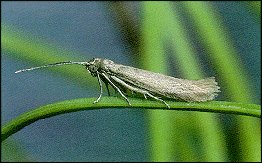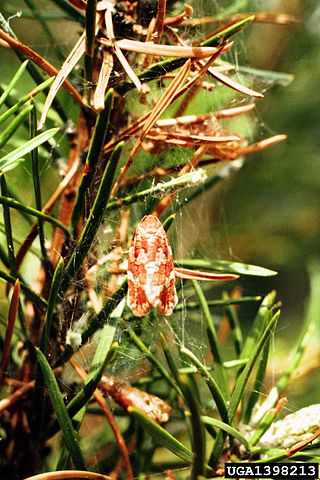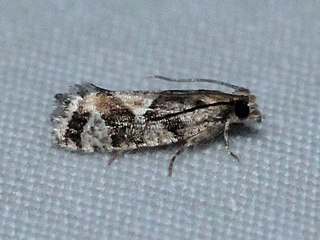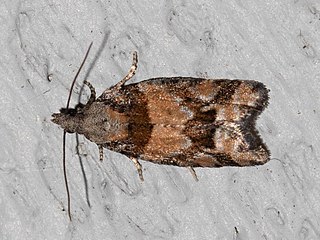
A spruce is a tree of the genus Picea, a genus of about 40 species of coniferous evergreen trees in the family Pinaceae, found in the northern temperate and boreal (taiga) regions of the Earth. Picea is the sole genus in the subfamily Piceoideae. Spruces are large trees, from about 20 to 60 m tall when mature, and have whorled branches and conical form.

Choristoneura is a genus of moths in the family Tortricidae. Several species are serious pests of conifers, such as spruce and are known as spruce budworms.

The Tortricidae are a family of moths, commonly known as tortrix moths or leafroller moths, in the order Lepidoptera. This large family has over 11,000 species described, and is the sole member of the superfamily Tortricoidea, although the genus Heliocosma is sometimes placed within this superfamily. Many of these are economically important pests. Olethreutidae is a junior synonym. The typical resting posture is with the wings folded back, producing a rather rounded profile.

Larix laricina, commonly known as the tamarack, hackmatack, eastern larch, black larch, red larch, or American larch, is a species of larch native to Canada, from eastern Yukon and Inuvik, Northwest Territories east to Newfoundland, and also south into the upper northeastern United States from Minnesota to Cranesville Swamp, West Virginia; there is also an isolated population in central Alaska.

Choristoneura fumiferana, the eastern spruce budworm, is a species of moth of the family Tortricidae native to the eastern United States and Canada. The caterpillars feed on the needles of spruce and fir trees. Eastern spruce budworm populations can experience significant oscillations, with large outbreaks sometimes resulting in wide scale tree mortality. The first recorded outbreaks of the spruce budworm in the United States occurred in about 1807, and since 1909 there have been waves of budworm outbreaks throughout the eastern United States and Canada. In Canada, the major outbreaks occurred in periods circa 1910–20, c. 1940–50, and c. 1970–80, each of which impacted millions of hectares of forest. Longer-term tree-ring studies suggest that spruce budworm outbreaks have been recurring approximately every three decades since the 16th century, and paleoecological studies suggest the spruce budworm has been breaking out in eastern North America for thousands of years.

Archips occidentalis [or Choristoneura occidentalis in some schemes] is a species of moth of the family Tortricidae. It is found in the Gambia, and possibly more broadly, such as Democratic Republic of Congo, Tanzania, and South Africa.

The Archipini are a tribe of tortrix moths. Since many genera of these are not yet assigned to tribes, the genus list presented here is provisional.

Coleophora laricella, the western larch case-bearer, is a moth belonging to the family of case-bearing moths Coleophoridae. It is native to Central and Northern Europe, with its original food source being the European larch or Larix decidua. However, it was introduced to North America in the mid-19th century where it has gained a wide range and become an invasive defoliator of several species of the genus Larix, particularly the western larch Larix occidentalis and the tamarack larch Larix laricina.

Choristoneura pinus, the jack pine budworm, is a moth of the family Tortricidae. The species was first described by Thomas Nesbitt Freeman in 1953. It is found in jack pine forests in Canada from Atlantic provinces to Cypress Hills on the Alberta-Saskatchewan border as well as northern United States from New England to the lake states.

Zeiraphera canadensis, the spruce bud moth, is a moth of the family Tortricidae. It is a small brown moth mainly found in North America, specifically New Brunswick, Quebec, and the north-eastern United States. The adult moth flutters quickly, and stays low among trees during the day and higher above tree cover after sunset. The spruce bud moth relies primarily on the white spruce tree as a host plant. Both male and female spruce bud moths mate multiply, however males have the ability to secrete accessory gland proteins that prevent female re-mating. The moth is univoltine, meaning only one generation hatches per year, and its eggs overwinter from July to May. The species Z. ratzeburgiana is very similar to Z. canadensis and can only be distinguished by the presence of an anal comb in Z. canadensis.

Acleris semipurpurana is a species in the moth family Tortricidae, and one of several species of moth commonly known as oak leaftier or oak leaf tier. The larvae feed on the leaves of oak trees in the Eastern United States and southeastern Canada which can be a major cause of defoliation. The loss of leaves can kill or damage the affected trees, which are chiefly in the Lobatae or red oak section of Quercus, or oaks.

Archips semiferanus is a species of moth in the family Tortricidae, and one of several species of moth commonly known as oak leafroller or oak leaf roller. The larvae feed on the leaves of oak trees in the eastern United States and southeastern Canada and are a major defoliator of oak trees, which can lead to tree mortality. In Pennsylvania in the late 1960s and early 1970s, oak leafrollers defoliated over 1,045,000 acres (423,000 ha).

Epinotia nanana, the European spruce needleminer, is a moth of the family Tortricidae. It is found from northern and central Europe to Russia and Mongolia.

Argyrotaenia dorsalana is a moth of the family Tortricidae. It is found in western North America from southern British Columbia south to California, Arizona, and New Mexico.

The spongy moth, formerly known as the gypsy moth, was introduced in 1868 into the United States by Étienne Léopold Trouvelot, a French scientist living in Medford, Massachusetts. Because native silk-spinning caterpillars were susceptible to disease, Trouvelot imported the species in order to breed a more resistant hybrid species. Some of the moths escaped, found suitable habitat, and began breeding. The gypsy moth is now a major pest of hardwood trees in the Eastern United States.

Orgyia pseudotsugata, the Douglas-fir tussock moth, is a moth of the subfamily Lymantriinae first described by James Halliday McDunnough in 1921. It is found in western North America. Its population periodically irrupts in cyclical outbreaks. The caterpillars feed on the needles of Douglas fir, true fir, and spruce in summer, and moths are on the wing from July or August to November.

Epinotia radicana, the red-striped needleworm moth, is a species of moth of the family Tortricidae. It is found in western Canada, including British Columbia and Alberta.

Lymantria dispar dispar, commonly known as the gypsy moth, European gypsy moth, LDD moth, or North American gypsy moth or spongy moth, is a species of moth in the family Erebidae. It has a native range that extends over Europe and parts of Africa, and is an invasive species in North America.

Neodiprion abietis, commonly known as the balsam fir sawfly, is a species of insect in the family Diprionidae. It is found in North America from Canada to northern Mexico and is phytophagous, feeding on the needles of coniferous trees.
Choristoneura biennis, the two-year-cycle budworm moth, is a species of moth of the family Tortricidae. It is found in Canada, where it has been recorded from Alberta and British Columbia.





















